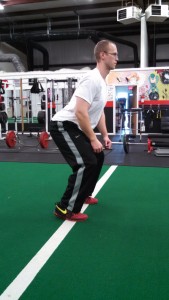If you’ve been around athletics for long enough, you have probably heard, or seen a coach tell their athletes not to take a “false step.” By false step I mean your first step from a static position is actually in the opposite direction that you intend to go. For example, I am in an athletic stance (feet even and shoulder width apart, knees bent, chest up) and I intend to sprint forward. To accomplish this, I accelerate forward by first taking a quick step backwards and then I sprint forward. A quick conclusion can be drawn (and often is) that this initial step backwards will slow me down. You are thinking “obviously, if my first step is backwards I am wasting valuable time and therefore taking more time to accelerate than I should.” As intuitive as this may seem, I am a firm believer that this is incorrect. Allow me to explain…
For the sake of this discussion, we are only going to look at human motion in a linear pattern (forward and backward). Moving your body is totally dependent on applying force through your legs into the ground, and the ground returning that force back to your legs in the opposite direction of which you applied it; that is, I push my leg  into the ground in a down and back fashion, and the ground pushes back on my leg up and forward. It is this continuous cycle of force application and redirection that leads to me moving forward.
into the ground in a down and back fashion, and the ground pushes back on my leg up and forward. It is this continuous cycle of force application and redirection that leads to me moving forward.
Now, when I begin motion out of an athletic stance, my feet are directly (or at least very close to being) under my hips. My center of gravity is directly over the top of where my feet are. At this point, my body is in a very good position to apply force straight down into the ground (remember that force will come straight back up-Newton‘s 3rd Law, for every action, there is an equal and opposite reaction). This is great if my desire is to jump vertically, but not if I want to sprint linearly. If my desire is to sprint forward, or backward, I need to redirect, or REPOSITION, my feet to give myself a mechanical advantage via improved angles and something to push off in order to overcome inertia. Remember, if I want to move forward I need to apply force down AND back. Taking this quick step backward, or forward, allows me to do just that. With my feet now separated I am in a much more advantageous position to move linearly.
Not sold? Below is an unbelievable example of this in action. Fast forward to about the 25 second mark and watch Marshawn Lynch take his first step (then enjoy why they call the man “Beast Mode!”).
https://www.youtube.com/watch?v=GNBQEv11C4c
Watch any sport, there are countless examples of this happening time and again. Do you want to try another example right now? Try jumping straight up without first squatting down and see how high you can get. Now, jump how your normally would and compare the results. This isn’t exactly comparing apples to apples but it does illustrate our force application and redirection. The same physics apply.
This repositioning step, or “plyo step” as we call it, is one of the very first things we go over when a new athlete comes into our facility. How do we coach this? It is really pretty simple, we just let nature take its course. More times than not, we will coach an athlete to just accelerate for a given distance and we will watch their footwork. Almost every time you will see them take this plyo step without even thinking about it. This is something that just seems to be hardwired into our movement patterns. As coaches, we tend to be perfectionists when it comes to how our athletes move and sometimes we need to take the less is more approach. The human body is hardwired to move and we just need to get out of the way from time to time and let nature do what it does. I have yet to come across any research data that says taking this plyo step is detrimental to acceleration times. Until this happens, I fully intend to let the human body do what it does when it comes to taking this plyo step.
To be fair, there are scenarios where the repositioning step is not needed. Using football for example, a linebacker may not take a plyo step if he is on a delayed blitz; a running back may not take one on a delayed handoff, off to his right or left. All things considered, a repositioning step is natural, intuitive and not to be un-coached.
As always, thank you for reading and I would love to hear your feedback on this controversial topic. Most people are in one corner or the other on this one, there really is no in between and I would love to hear your stance on it, pun intended.

